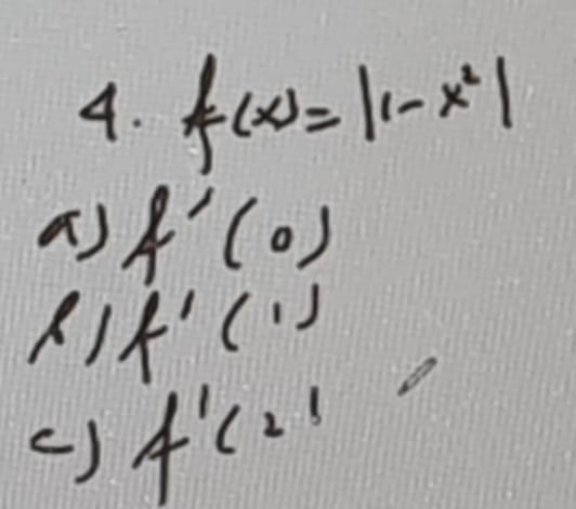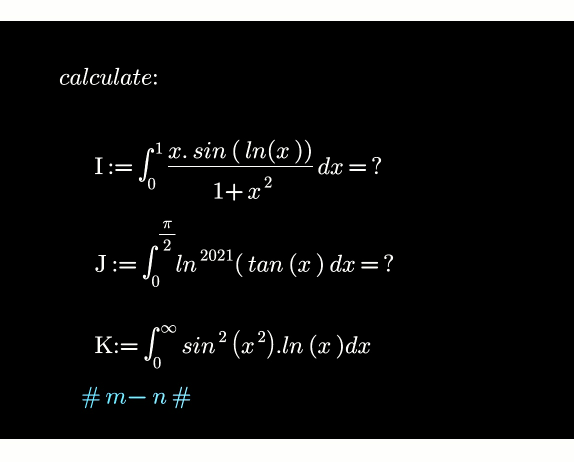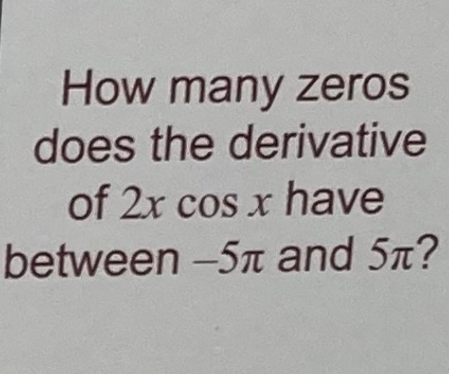
Question and Answers Forum
DifferentiationQuestion and Answers: Page 15










|
Question and Answers Forum |
DifferentiationQuestion and Answers: Page 15 |
| F(x)= 3cos x + 4sin x , F^((101)) ((π/2))=? |
| 1). Find (dy/dx) , if : a). y=(8x−1)(x^2 +4x+7) b). y=(3x^4 −10x+8)(2x^2 +5) 2). Find an equation of the tangen line to the graph of y=(5/(1+x^2 )) at each point a). P(0,5) b). Q(1,(5/2)) 3). Find the coordinat of all point on the graph of : y=x^3 +2x^2 −4x+5 at which the tangen line is: a). horizontal. b). paralel to the line y=2y+8x−5=0 4). Find point P on the graph of y=x^3 such that the tangen line at P has x−intercept 4 5). Find the points at which the graph f(x) and f^′ (x) is intersect , given that a). f(x)=x^3 −x^2 +x+1 b). f(x)=x^2 +2x+1 |
| Ω=∫_0 ^( ∞) log(sinh(x)).log(tanh(x))dx=((7ζ(3))/8) +(π^( 2) /8)ln^ (2) |
| Σ_(n=1) ^∞ (n ln(((2n+1)/(2n−1))) −1)=? |
| Π_(k = 1 ) ^n (1 + (1/k))^k = V_n find V_n |

|
| f :[ 0 , 6] → [−4 , 4] f (0 )=0 f (6 )=4 x, y≥0 , x+y ≤6 f (x+y )=(1/4){f(x)(√(16−(f(y))^2 )) +f(y)(√(16−(f(x))^2 )) } ∴ ( f(1) +f (3))^( 2) =? |
| If Ω = ∫_0 ^( ∞) (( ln^( 2) (x ).sin((√(x )) ))/x) dx prove that : Ω = 4 γ^( 2) + (π^( 3) /3) ■ m.n |

|

|
| prove that # ∫_0 ^( ∞) (( sin^( 3) ( x ).ln( x ))/x) dx =^? (π/8) (−2γ +ln(3)) .....■ m.n |

|

|
| Max & min value of function f(x)=(√(6−x)) +(√(12+x)) . |

|

|
| sin(9) + sin(21)+sin(39)=^? (ϕ/( (√2))) ϕ:= golden ratio m.n |
| Solve .. x , y , z ∈ R^( +) & x+ y= z K := Min_ ((( x^( 4) + y^( 4) + z^( 4) )/(x^( 2) y^( 2) )) ) = ? ■ Source : Elementary Olympid Book m.n |

|
| ∫_(−∞) ^( ∞) (( tan(x).Arctanh(cos(x)))/x)dx=? |

|
| prove :: 𝛗=∫_(−∞) ^( ∞) (( e^( −(1/x^( 2) )) )/x^( 4) ) dx =^? (1/2) Γ ((1/2) ) |

|
| 𝛗=∫_0 ^( ∞) ((sin(x ))/x)(((a^( 2) +cos^( 2) (x))/(b^( 2) + cos^( 2) (x ))))dx=? |
| prove that: S := Σ_(n=1) ^∞ ((( 1)/(sinh (2^( n) .x)))) =^? (( 2)/(e^( 2x) −1)) m.n... |
| nice..mathematics... Prove that... I= ∫_0 ^( ∞) (( cos (x ))/(cosh (x ))) dx=(π/( cosh ((π/2) ))) .......■ prepared :: m.n |